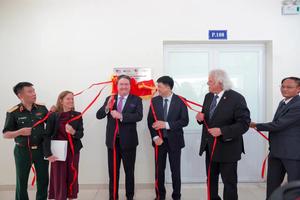30 Years of Vietnam-U.S. Normalization: From Reconciliation to Comprehensive Strategic Partnership
Monday, 04/28/2025 - 10:08 AM (GMT+7)
TCVM - The year 2025 marks a special milestone, signifying three decades since the normalization of relations between Vietnam and the United States (1995-2025).
This period has witnessed an extraordinary transformation, from former adversaries to close partners. Persistent efforts have built a solid foundation, with the bilateral relationship today not only demonstrating maturity and mutual trust but also playing a vital role in shaping peace, stability, and development across the region and the world.
The road to normalization was arduous. Both nations had to overcome significant post-war barriers, particularly the sensitive issue of accounting for Americans Missing in Action (MIA) and the enduring U.S. economic embargo, which severely impacted Vietnam’s society and economy.
Progress began as the Vietnamese government took proactive steps to address war legacies, including MIA accounting, clearing unexploded ordnance (UXO), and assisting Agent Orange/dioxin victims. Simultaneously, civil society organizations, diplomatic agencies, veterans, and citizens from both sides made crucial contributions to reconciliation efforts.
These relentless initiatives culminated on July 11, 1995, when Vietnamese Prime Minister Vo Van Kiet and U.S. President Bill Clinton officially announced the normalization of relations, ushering in a new era based on “shelving the past, overcoming differences, promoting commonalities, and looking toward the future.”
Following normalization, embassies were swiftly established, opening formal diplomatic channels. Economic ties were soon prioritized, leading to negotiations and the signing of the Bilateral Trade Agreement (BTA) in 2000. These milestones laid the diplomatic and economic groundwork for a robust bilateral relationship.
The Bilateral Trade Agreement’s entry into force in December 2001 served as a major catalyst, significantly boosting Vietnam-U.S. economic ties. Vietnamese exports to the U.S. soared, with bilateral trade growing exponentially. U.S. companies increasingly invested in Vietnam, fueling the country's dynamic economic development.
In 2002, the U.S. became Vietnam’s top export market, with turnover surging by 128%. This momentum bolstered Vietnam’s reform efforts and accelerated its international economic integration.
Continuing this trajectory, with strong U.S. support, particularly the Congress’s approval of Permanent Normal Trade Relations (PNTR) status, Vietnam officially joined the World Trade Organization (WTO) in January 2007. This milestone marked Vietnam’s deeper integration into the global economy and further solidified economic ties with the United States.
Beyond trade, cooperation expanded into critical areas such as health (through the U.S. President’s Emergency Plan for AIDS Relief—PEPFAR), education and training (with initiatives like the Fulbright Program), science and technology, and people-to-people exchanges. High-level visits became more frequent, and regular bilateral dialogue mechanisms—on political, security, and defense issues—helped strengthen mutual understanding and trust.
A major turning point came in July 2013 when Presidents Truong Tan Sang and Barack Obama declared the establishment of the Comprehensive Partnership, structured around nine key pillars. It was built on principles of respect for the United Nations Charter, international law, political systems, independence, sovereignty, and territorial integrity, signifying the maturity of the Vietnam-U.S. relationship after nearly two decades of normalization.

During the historic visit in July 2013, President Truong Tan Sang and U.S. President Barack Obama jointly announced the establishment of the Comprehensive Partnership between Vietnam and the United States. (Photo: VNA)
Building on the Comprehensive Partnership, bilateral ties continued to deepen, propelled by converging strategic interests and a shifting regional landscape. Shared priorities in maintaining peace, stability, and the rule of law—especially in the South China Sea—became key drivers of enhanced cooperation.
A historic milestone came during President Barack Obama’s visit to Vietnam in May 2016, when he announced the complete lifting of the U.S. ban on lethal weapon sales. This decision, symbolic of shedding the final vestiges of war, also opened the door to substantive defense collaboration and greater access to advanced U.S. defense technology for Vietnam.
Maritime security cooperation intensified, with the U.S. supporting the Vietnam Coast Guard through the transfer of cutters, equipment provision, and training initiatives. Historic visits by U.S. naval vessels, including the USS Carl Vinson in 2018, symbolized the growing strategic closeness.
Meanwhile, collaboration on war legacy issues remained a bedrock of trust-building. The dioxin remediation project at Danang Airport was successfully completed in 2018, followed by the launch of an even larger-scale remediation project at Bien Hoa Airport in 2019. UXO clearance and MIA accounting continued effectively, highlighting the enduring humanitarian commitment from both nations.
Economically, Vietnam-U.S. trade flourished, with turnover surpassing the $100 billion mark. Vietnam emerged as a key player in global supply chain diversification and an attractive destination for U.S. high-tech investment. However, the persistent U.S. trade deficit with Vietnam occasionally posed challenges, addressed through dialogue mechanisms like the Trade and Investment Framework Agreement (TIFA).
Political trust was further consolidated through frequent high-level exchanges and the expansion of dialogue mechanisms. All these developments laid the foundation for a historic elevation of the bilateral relationship.
In September 2023, during a State Visit to Vietnam by U.S. President Joe Biden, both countries officially upgraded their ties to a Comprehensive Strategic Partnership for peace, cooperation, and sustainable development—the highest level in Vietnam’s partnership hierarchy. This upgrade reflects high political trust and a shared strategic vision, opening new avenues for collaboration in semiconductors, AI, climate change response, and other cutting-edge fields.

The late General Secretary Nguyen Phu Trong and U.S. President Joe Biden
Three decades after normalization, the Vietnam-U.S. relationship stands as a remarkable example of post-war reconciliation and building mutually beneficial partnerships. Reflecting on this journey, General Secretary To Lam described it as "a rare and exemplary model in international relations for healing and post-war cooperation."
He emphasized, “This achievement is the crystallization of countless persistent efforts to heal wounds and build trust over three decades by generations of leaders, governments, legislatures, and peoples of both countries.”
From deep suspicions and fundamental differences, Vietnam and the United States have tirelessly pursued dialogue, substantive cooperation, and trust-building—particularly through joint efforts to address war legacies. These efforts paved the way for breakthroughs across every field.
The establishment of the Comprehensive Strategic Partnership is not merely an achievement of the past but a strong commitment to the future. It promises substantial benefits for both nations, from economic growth and enhanced international standing to strengthened regional security and stability.
As General Secretary To Lam noted, echoing the words of late General Secretary Nguyen Phu Trong during his 2015 visit to the U.S., "We can together build a bright vision for the future relationship between our two countries, so that our two peoples, our children and grandchildren, will always be good friends and partners."
The potential for future cooperation is immense, especially in high-tech sectors, the digital economy, clean energy transitions, and tackling global challenges such as climate change. Realizing this potential will require maintaining frank, constructive dialogue at all levels, respecting differences—including political systems and human rights perspectives—and effectively managing outstanding trade and economic issues amid a complex global environment.
With strong political will, public support, and a solid foundation laid over thirty years, the Vietnam-U.S. Comprehensive Strategic Partnership—built on mutual respect, equality, and shared benefit—promises to continue flourishing, contributing positively to peace, stability, cooperation, and prosperity in the Indo-Pacific and beyond.
Thu Hien - Kim Hieu
Tag (S):




